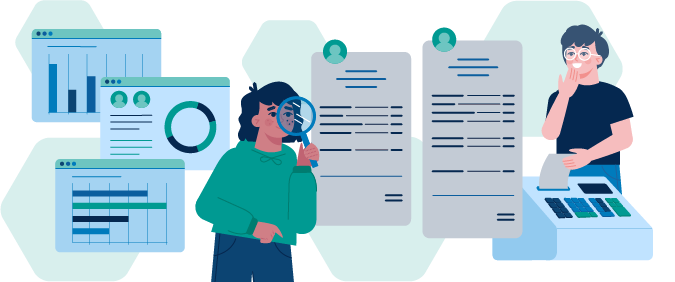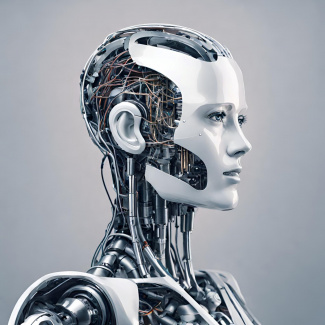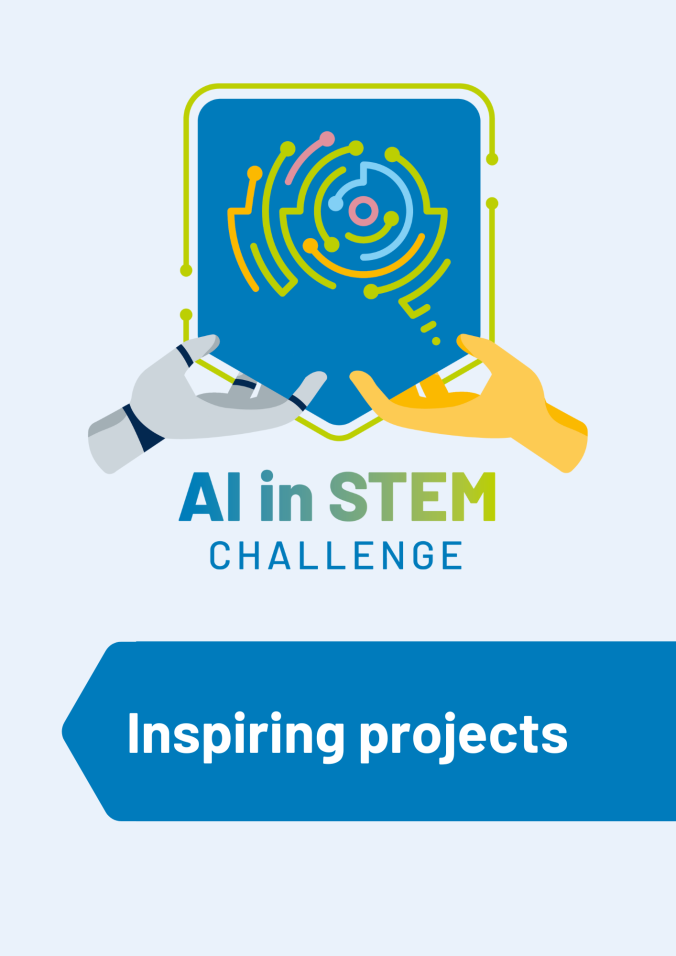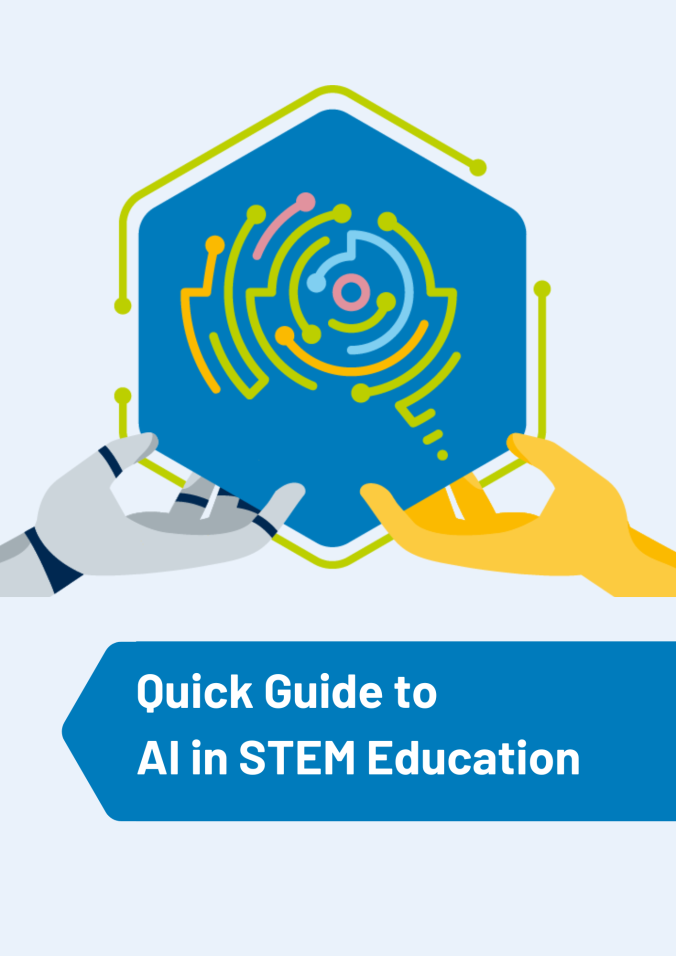First Steps in AI and Data Analysis

Overview
Overview
Keywords: AI, machine learning, robots, technology, ICT, big data
Subjects: Technology, STEM, computing
Other disciplines: Social sciences, maths
Age group: 10–14
Required knowledge/skills: None required
Time frame: Either 6 x 1 hour lessons, or a full day project
Cooperation partners: Potentially a university or community partners who work with AI and/or ML
Required hardware / software / online services and tools
- Internet access
- PCs, laptops, or tablets
- Text, music and image generation tools (some require free accounts)
- Zooniverse is free and can be accessed without signing up
Author: Paul Tyler (UK)
Artificial intelligence (AI) and machine learning (ML) are the technologies that are likely to have the greatest day-to-day impact on young people’s lives across the world over the next five to ten years. Starting to teach them about it and how to use the technology responsibly, from an early age is very important.
The development of AI and ML technology has happened so quickly that school curriculums haven’t had time to adapt and there is very little specific guidance, or resources, published to support teachers.
Allowing students opportunities to explore AI and ML applications in a safe space with clear guidance will let them develop an understanding of the different contexts in which the technology can be used and the impact it can have. There are already many misconceptions about AI and how it might develop in the future. Misinformation and ‘fake news‘ are prevelant across the internet and it is crucial to ensure students are properly educated about this and are prepared for the truth.
AI and ML technology are moving so fast (4 ChatGPT versions in six months to January 2024), and new tools are constantly being developed and released. There are already freely available online AI applications for creating text, images, music, video, translating languages and so on, and the opportunities are only going to expand over the next few years.
Activity 1: Defining artificial intelligence and machine learning
Texts and additional materials for this activity are provided in this editable PPT presentation.
Students work in small groups to discuss the questions:
- What do you think artificial intelligence and machine learning are?
- What do you know about artificial intelligence and machine learning?
Groups make notes as they discuss the questions. Groups feedback to the class and discuss the similarities and differences in what they know. The teacher can create a mindmap of ideas on the board.
Show students the definitions of AI and ML that have been created by ChatGPT and Google Gemini.
Many chatbots such as ChatGPT and Google Gemini require you to set up a free account. You can then input a prompt such as, “Write a short definition of Artificial Intelligence to explain it to a 10-year-old child.” Examples of outputs are given in the PPT presentation.
ChatGPT can currently be used in several languages, including English, Spanish, French, German, Portuguese, Italian, Dutch, Russian, Arabic, and Chinese.*
Google Gemini supports over 40 languages.*
*Information correct as of February 2024.
How close were the students’ ideas to the definitions written by the AI chatbots?
Ask students to identify current uses of AI & ML that they think already affect their daily lives. Make a list on the board and compare it to the list in the PPT file.
Show students this short video to explain the difference between AI and ML:
Ask students to discuss possible future applications of AI and ML and how they think those could impact their lives – both positively and negatively.
Activity 2: Supermarket secrets
In this activity students work in pairs to learn about data collection. Editable versions of the material for this activity can be found in this PPT: Supermarket Receipts. An editable version of the texts “Supermarket Secrets” is available in this word file and as a PDF here.
Give each pair of students Shopping Receipt 1 and ask them to look at it carefully and note down as much information about the shopper as they can. Discuss the findings as a class.
- Think about how this information could be useful to a supermarket and why they might want to collect this data.
Give each pair of students Shopping Receipt 2 and ask them to look at it carefully and note down as much information about the customer as they can. Discuss the findings as a class.
- How do you think they collect the data and link it to a particular customer?
Supermarkets collect huge amounts of data from their customers – this is called “BIG data“. Supermarkets use AI & ML to analyse this data and find customers’ purchasing patterns. This allows them to target adverts and special offers to individual customers.
Students read "Supermarket Secrets: How Your Loyalty Card Talks to Robots!" (Word / PDF)
Written by Google Gemini
Ever wondered why the cereal you loved suddenly vanished from the shelves, or why you get coupons for carrot sticks just when you were thinking about them? It's not magic, but it's pretty close! Supermarkets have sneaky little helpers called robots, powered by Artificial Intelligence (AI), that use information from your loyalty card to predict what you'll buy and make the store better for everyone.
Imagine your loyalty card as a chatty chipmunk, whispering what you buy to a giant, friendly robot brain. This brain collects whispers from all the chipmunks, then uses its AI muscles to understand what everyone loves (like mountains of ice cream!) and what's not so popular (sorry, brussels sprouts).
Here are some cool things these robot brains can do with your whispers:
Treasure Hunt: Ever noticed how milk and bread are always at the back of the store? That's not a coincidence! The robot brain figured out most people buy these things every time, so putting them far away encourages you to explore and buy other stuff. It's like a supermarket treasure hunt!
Coupon Caper: Remember those carrot coupons? The robot brain noticed you bought broccoli last week, so it guessed you might like other healthy snacks. It's like having a personal shopper whispering deals in your ear, helping you save money and eat your veggies!
Shelf Shuffle: The robot brain also sees which products disappear quickly from the shelves and which ones gather dust. This helps the supermarket stock the popular stuff more often and maybe even introduce new snacks you'll love based on what other chipmunks are buying.
Happy Shopper Party: But all this whispering isn't just about selling more stuff. The robot brain wants you to have a happy shopping trip! It remembers when the checkout lines get long and tells the supermarket to open more registers. It even sees which products are confusing or hard to find and tells them to put them in better places.
Of course, you might be wondering, "Isn't this a bit creepy?" It's true, super shiny robots collecting our shopping data sounds a bit like something from a movie. But remember, the robot brain doesn't know who you are, just what you buy. It's like your whispers are anonymous, helping make the supermarket a friendlier, tastier place for everyone.
So next time you swipe your loyalty card, remember the friendly robot brain behind the scenes, working hard to make your shopping trip super! Think of it as a high-tech game of "I Spy" with benefits – everyone wins!
- Does your family use loyalty cards?
- Did you know how supermarkets use the data?
- Do you think this is a positive or negative way to use data about your shopping habits?
The following short video will explain to older students how data analysis with AI can be done. The benefit of AI is that scaling it up to analyse data for millions of customers can be done very easily and quickly.

Activity 3: Rolling the dice
Students work in pairs rolling two dice and recording the total of the two dice using tally marks. Let them roll for about 10 minutes to collect as much data as possible.
Collate all the data in a spreadsheet and show children how the software can total up all the columns in seconds and then be used to plot a graph to show the patterns that the data shows. There is a Dice Data spreadsheet available to download which is set up for you to input your students’ data. There is also a worked example with data input from a real class.
This dice simulator lets you see the patterns that emerge as data is collected in real time.
We need computers to be able to analyse huge data sets and identify patterns – which would take humans an impossibly long time to do. This ability to handle huge amounts of data is something computers are excellent at and it is the starting point for AI and ML.
Two examples of handling huge amounts of data are the MET Office (weather service) in the UK and the European Centre for Medium-Range Weather Forecasts (ECMWF). Both organisations use some of the most powerful computers in the world to process hundreds of billions of data points every day to forecast the weather across Europe, and beyond. The supercomputers used by both organisations are capable of performing 1000s of trillions of calculations every second!
Both the MET Office and ECMWF are now starting to use AI and ML to process and analyse the data they collect, identify patterns and help forecast the weather. The main advantage of this is the amount of data that can be processed in a short space of time, efficiently and cheaply. This article – ‘Capturing uncertainty in forecasts based on AI’ explores the advantages of using AI systems in weather forecasting.
These two videos examine the improvements AI can make to weather forecasting and how that can improve safety and ultimately save lives.
Activity 4: Experimenting with chatbots
One application of AI is generative Large Language Models (LLMs) such as Google Gemini and ChatGPT. Generative refers to any AI tools that can create new content, whether that content is text, images, audio or video.
Students are going to explore some of the generative large language models (or chatbots) on the internet. This can be done as a whole class working together, or by pairs or individuals working on a device.
Students use a chatbot like Chat GPT or Google Gemini to create some texts – these can be fictional stories, biographies, or factual texts about a subject. Students will gain an understanding of the importance of the human input element and how the information they input can be refined to alter the AI text output.
The AI chatbots all carry warnings about the accuracy of the content they have created: ‘ChatGPT can make mistakes. Consider checking important information.’ It is important to get students into the habit of always checking the accuracy of what has been created, especially if the content is factual. This proofreading step is good practice in all situations and can be taught alongside the concepts of critical literacy.
Write a 300-word* story, suitable for 11-year-olds+, about an adventurous aardvark who sets off to find some hidden treasure.
*Always specify the word length – short texts are written quicker.
+Always specify age suitability. This will ensure that nothing inappropriate is included and that the vocabulary level is appropriate.
Write a 300-word article, suitable for 10-year-olds, about endangered species in Europe.
Write a 250-word biography of scientist Marie Curie suitable for 12-year-olds.
See the ‘Large Language Model Examples’ document (word file and PDF) for more generative AI examples.
- Ask multiple students to input exactly the same prompt and see what output they get.
- Ask students to edit their prompt to be more specific and see how that changes the output.
- Try prompts that include specific types of writing; for example, a diary entry, a story in the first person or a factual piece including bullet points and a glossary.
Activity 5: Experimenting with music and image generators
LLMs are only one application of AI. AI can also be used to translate languages, play video games, or create and perform music.
Demonstrate an AI music generator, like Riffusion, to show how AI can take your lyrics and put them into a song of the style you choose.
Demonstrate to students how Google Translate can translate over 130 languages. It can translate from typed words, spoken words and from images.
- Give students a text in a different language, Mandarin for example, and ask them to translate it.
- Pair students up and challenge them to have a conversation in a different language using two devices.
Students try using Canva or Dall.E to create their own images by inputting text descriptions. Let students explore creating different image types and what happens as they edit their text descriptions. See ‘AI Generated Image Examples’ (PPT and PDF) for examples of prompts, the images AI can create, and some of the limitations of AI image generation.
Discuss the ethical issues around AI image generation – scraping, copyright, ownership and accountability. This article is an excellent starting point. This video explains how AI image generation works:
More links and resources regarding ethical, social and ecological implications of artificial intelligence can be found in the background article to the AI in STEM Education project: AI in Education: Theory and Practice.




Activity 6: Exploring citizen science projects
Machine Learning is when humans train a computer to carry out a specific task. After a period of initial training the computer is able to continue learning for itself and improving its performance.
In this activity, students use a Zooniverse project to train computers to analyse scientific data. Projects such as Tag Trees and Whale Chat use AI and ML to train computers to identify specific objects from video or photos.
Note: Zooniverse Citizen Science projects change quite regularly but you can still access paused or archived projects. Projects such as The Plastic Tide are archived but it is still possible to interact with the data if you click ‘Get Started’.
Machine Learning requires as much data as possible to ensure it is accurate. Scientists use citizen science projects because 1000s of users can provide the data much faster than they could. Once the AI system has enough data it can perform the analysis itself, improving as it adds data. Read more in this article; Artificial Intelligence, citizen science and the democratization of science.
Students can also try Teachable Machine – an online tool where they can train a computer to recognise shapes, colours, movements and sounds and then sort through data to identify them.
In our teaching resource “EcoKids Teach AI” targeted to younger students, a Teachable Machine model is trained to classify recyclable waste.
Career orientation
AI is going to be hugely relevant to almost every job in the future and students should be given the opportunity to find out about how careers might be affected by and evolving with AI in the future.
A selection of articles and videos, engaging interviews and useful teaching resources can be found on this page: Artifical intelligence – career orientation.
The Primary Science Teaching Trust’s ‘A Scientist just like me’ programme has compiled short profiles of scientists working with AI and machine learning.
Here you can download the PDFs directly:
Artificial Intelligence Researcher – Krishna Mooroogen
Data Scientist – Dr. Fiona Reid
Machine Learning Scientist – Kaushik Hatti
Software Engineer – Rebecca Harding
Conclusion
Artificial Intelligence and Machine Learning are going to have a huge impact on students’ lives, and it is important that they start to learn about the possibilities, and pitfalls, from an early age.
Given the rapid development of AI technologies from the start of 2023, there are always going to be new and improved opportunities for students to try using AI and ML. Keep an eye out for the latest developments, especially as the technologies suggested in these teaching materials are superseded.
It is an exciting time to be learning about these technologies and be in a position to try them out and gain an understanding of how they work.
Activity 1–3:
PPT: First Steps in AI and Data Analysis
Activity 2:
Activity 3:
Activity 4:
Word: Large Language Model Examples
PDF: Large Language Model Examples
Activity 5:
Zooniverse projects:
https://teachablemachine.withgoogle.com/
https://tm.gen-ai.fi/image/general (GDPR-safe)
Videos and articles
YouTube: AI vs Machine Learning
YouTube: Data Analysis with AI
Article: Capturing uncertainty in forecasts based on AI
YouTube: Can AI help weather forecasting save lives?
YouTube: Machine Learning for Weather Forecasts at ECMWF
Article: Ethical Pros and Cons of AI Image Generation
Article: Artificial Intelligence, citizen science and the democratization of science
Share this page



